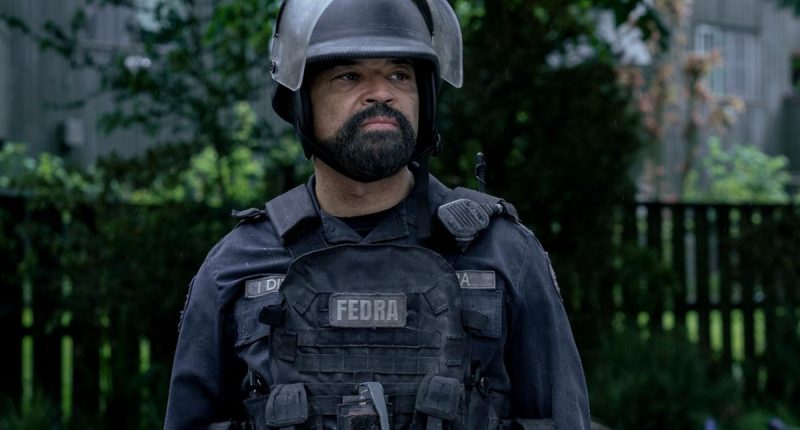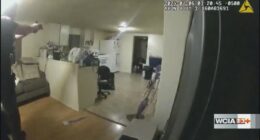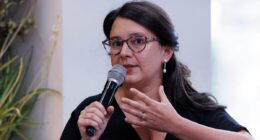Share this @internewscast.com
The Last of Us Season 2 continues to follow the intense journey of Ellie (Bella Ramsey) and Dina (Isabela Merced) as they pursue vengeance against five new characters: Abby (Kaitlyn Dever), Owen (Spencer Lord), Manny (Danny Ramirez), Mel (Ariela Barer), and Nora (Tati Gabrielle). This group is responsible for capturing, torturing, and ultimately killing Joel (Pedro Pascal), removing the show’s former main protagonist. These characters are part of an organization newly introduced in the series, known as the “Wolves.”
The start of Episode 4 in Season 2 of The Last of Us takes us back in time to uncover the harsh beginnings of the Washington Liberation Front, abbreviated W. L. F. Similar to other cities depicted in the series, Seattle is shown under the authoritarian control of FEDRA. Predictably, the city’s populace began a revolt. In Seattle’s case, the rebellion stood a chance due to the backyard militia persuading a high-ranking FEDRA officer to join their movement…
**Spoilers for The Last of Us Season 2 Episode 4, now streaming on MAX**
The episode revisits Seattle from eleven years ago, during FEDRA’s dominance. Fictional events unfold inside a military transport vehicle filled with FEDRA officers. Among them is a character, portrayed by Josh Peck, who derogatorily refers to people as “voters.” This intrigues a new recruit named Burton (played by Ben Ahlers, known for his role in The Gilded Age). Curious about the term, Burton questions its usage. Sgt. Isaac Dixon (Jeffrey Wright) enlightens him that “voters” is a term of mockery, originating from a time when citizens had a say in their governance—a right now stripped away by FEDRA’s oppressive regime.
The vehicle comes to a stop and Dixon meets a local “voter” leader named Hanrahan (Alanna Ubach). The sergeant takes Burton with him under the auspice of teaching the newbie how these tense stand offs are done. Instead, we watch Dixon turn to Hanrahan’s side. He coldly unpins a grenade, throws it into the back of the truck, and locks the door, killing all the FEDRA soldiers inside. Burton is then given the unenviable choice to join the Washington Liberation Front or die.
This sequence establishes how the Washington Liberation Front was eventually able to defeat FEDRA, with the help and strategy of Isaac.
Still confused about who the Wolves are in The Last of Us Season 2? Here’s everything you need to know about the WLF…
Who are the Wolves in The Last of Us Season 2? All About Isaac Dixon, the Washington Liberation Front, and WLF:
The “wolves” in The Last of Us Season 2 are just members of the WLF, or Washington Liberation Front. This militia roared to life eleven years before the events of The Last of Us Season 2, when local citizens and disaffected soldiers like Isaac Dixon joined forces to kick FEDRA out.
However, once FEDRA was out, the Wolves had a new problem. Namely the Seraphites.
Last week’s episode of The Last of Us introduced us to the weirdly antiquated cult, which believes in only using “tech” from after the pandemic. Ellie and Dina stumble upon a mass grave of Seraphites, including children. Who killed them? Well, the Wolves did, of course.
Later in The Last of Us Season 2 Episode 4, Ellie and Dina discover that the Seraphites aren’t necessarily non-violent victims. They discover another scene of mass murder. This time around, the Seraphites have hung Wolves and then disemboweled them.
It’s all very gross and very horrific. The WLF and Seraphites are locked in a sectarian civil war of attrition. Isaac Dixon is now a man who tortures “Scars” with scalding cookware. Wolves kill anyone who’s not them out of fear. Seraphites retaliate, in turn.
At some point in the five years between The Last of Us Seasons 1 and 2, Abby and her friends journeyed to Seattle and joined the WLF because they were the last Fireflies left. Now, though, they aren’t locked in a freedom fight against FEDRA, but this wild civil war with the Seraphites.
(function(d, s, id) {
var js, fjs = d.getElementsByTagName(s)[0];
if (d.getElementById(id)) return;
js = d.createElement(s); js.id = id;
js.src = “//connect.facebook.net/en_US/sdk.js#xfbml=1&appId=823934954307605&version=v2.8”;
fjs.parentNode.insertBefore(js, fjs);
}(document, ‘script’, ‘facebook-jssdk’));
















